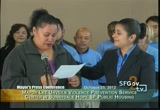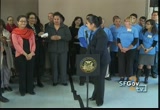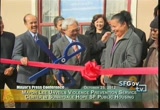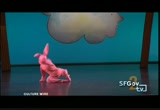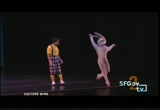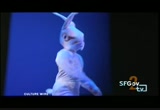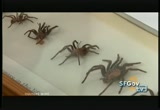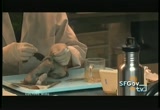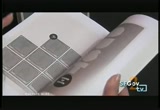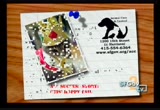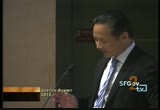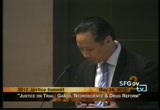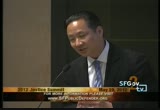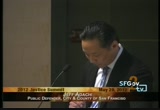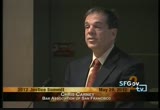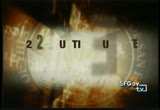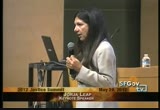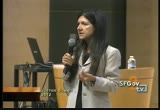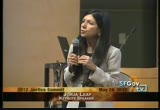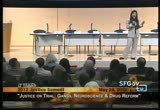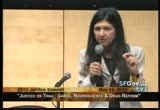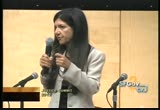tv [untitled] November 6, 2012 12:00am-12:30am PST
12:03 am
>> when there's good children's theater, it is good theater. if it is good theater, you would like it. even if it is for children that, is what i think. i know for the velveteen rabbit, i feel it is a story for kids and much older people. it is about being a young child and loving a toy or friend and it is also about what it means to get old. in 1986 my son was 2. i decided i would like to adapt the velveteen rabbit. mind you, i had never read it as a child but heard it as a mother. my first time was a bedtime
12:04 am
story recording. it was through that that i defined the theme and really determined how i was going to produce the story. is it true listening to it. when i made the dance i watched my son, since i have been taking him to live performances since he was 6 years old. he loved it when he saw his peers or when someone was reading to him or he heard language. early when the bunny first comes out they go, ah, the rabbit. i think talking, flying, something they can relate to. and the adults love nana. nan na is the main adult
12:05 am
figure in the show. the fairy is played by the same person. fair is very much like the love for your first child. pure love. nature is a beautiful thing. all wild rabbits come from nature. i think nature is mysterious, beautiful, not something our kids get very much these days. there's fantastical spectacle because of computers and film. i think in live performance, in a way being paired down, you can be more successful and ask everybody to buy into the world you are in. if it is a simple world they will buy in, as long as the world is consistent that you have on stage.
12:06 am
in some ways i also want that message for kids. it doesn't have to be spectacle but how you feel and having fun and taking things seriously, not about being blown away. >> what is real? it is a thing that happens to you when a child loves you for a long, long time. >> i think it is a success. for the most part if you are three to seven, you sit in the seats and most of the time the kids are engaged. they laugh and ask questions. i think that is success. the fact we tour it and do it here, it is lasting. i really want to say the reason it is lasting is
12:07 am
because of the story marjorie williams wrote is a gem of a story. if it was just an okay story, it wouldn't have lasted this long. i have had people say that is the first show i ever saw, that is why i am a choreographer. i have had people that have come back when they are 20 and 23 years old. little kids and people in their 50s and 60s are telling me how much they love it. they come back more than once, they come back year after year. >> when the new california academy of sciences opened in 2008, it quickly became one of the top tourist magnets in the city. part of the cal academies'
12:08 am
astronomical success is the weekly nightlife party. >> i am joined by helen, who is here to school me on all the nocturnal activities that are getting ready to take place here. tell us a little about what we can expect to see at nightlife. >> we open up the doors every thursday night at the california academy of sciences. there are certain things you can see every week you can go to the museum, visit the planetarium, and we bring in bars and a deejay or band. it is a different feel from during the day, something different every week. tonight , we have beer and music. -- tonight we have great beer and music. it is beer week. we have a dozen local brewers in african hall. we have a deejays to set up throughout the museum and a live performance at 9:00 p.m. tonight. >> what has been your favorite part as a participant or as an
12:09 am
observer? >> my favorite part is to walk around the aquarium in to see people with a drink in their hands, getting to know maybe somebody new, may be looking for a day, or chatting with friends. there jellyfish. i mean, they are beautiful. >> the culmination of the animals. >> it is very impressive. we do not have this at home. >> tell us a little about some of the spider's we see here on display. >> at the california academy of sciences, there is a very large collection of preserved and live specimens, which are the evidence about evolution. we have the assassin spiders, which are spiders that exclusively kill and eat other spiders. they are under the microscope here. research done and the california academy's i rhinology lab
12:10 am
suggests that the assassin spiders have been doing this for over 150 million years. this glassed in room is a real scientific laboratory, and the people in that room are preparing specimens of vertebrate, that is mammals and birds. the way they do this is to remove the skin, sew it together in a relatively lifelike pose, and ensure that it does not decompose. >> i am a really big class actress fan, so i am here to see them, and beer week. >> i wanted to learn something and have fun. >> i always enjoy it. i am not all is well -- always working as i am tonight. sometimes i come to enjoy the music and to dance. ♪
12:11 am
>> culturewire covers the arts in san francisco, and one of my favorite culture artists is here tonight. jason, thank you for being on culturewire. tell us about some of your posters that we have here today. >> most of the posters here are four specific shows or tours. i am hired by the bands or the venue. >> what is the inspiration behind these posters? >> no, disease of the related to the bay and, of course. music -- it is related to the band, of course the musical content or isn't related to the bed. album covers can come from anywhere. ♪ ♪
12:12 am
>> class actress was great. we have been having so much fun. i did not realize how beautiful the cal academy looks than that. what other events take place here? >> we do corporate events that night on a regular basis. but nightlife is your best bet to come in as a regular person pharmacy the academy at night, and visit with friends. calacademy.org/nightlife. we have details for the next few weeks. you can get tickets online in advance or at the door. >> thank you so much. thank you for watching culturewire on sf gov tv.
12:15 am
>> i am jeff idakia, and i provide legal representation to 20,000 people every year. it is our goal to ensure that we have the best legal representation possible. we started this nine years ago, to increased consciousness and awareness of the issues that affect public safety in criminal and juvenile justice reform. i am proud to say that this is the ninth summit. we take on issues like closing the california youth authority. and we in the confinement of
12:16 am
youth -- young children in -- and the prisoner re-entry program and abolishing the death penalty. we take on three critical issues. the first panel has a riveting discussion about gangs. and reducing gang violence. on our panel are former gang members, gang intervention workers, police, public defenders, and researchers. we talk about strategies to reduce gang violence. i will introduce the keynote speaker in a moment. the second panel is a cutting edge -- cutting edge discussion about the relationship between
12:17 am
the human brain and criminal behavior. we have top experts from all parts of the country to talk about what the brain research shows. that is the key to understanding how human beings behave, and why they may commit acts of violence. the afternoon's panel will have a debate about a proposed law that would reduce felony drug possession crimes to a misdemeanor. this is what 13 states have done. we not only bring these issues to the forefront, but have the opportunity to participate -- and we have cards that you could fill out and questions. this promises to be a year of reform and change like we have never seen, and we now see
12:18 am
prisoner reentry programs being implemented. we're still spending too much money and resources and not enough on rehabilitation and reentry. this november, the voters will decide on limiting the three strikes law. issues and measures long overdue. it is clear there is much more that needs to be done. according to a study that was published this month -- since 1989, 2000 people have been wrongfully incarcerated and they served collectively, 10,000 years. an average of 11 years person. i would like to thank the people who made this summit possible.
12:19 am
memoranda -- amy devon -- many volunteers and all of our speakers and panelists. i would like to thank the co- sponsors, and the bar association of san francisco. i would like to thank them for their help and support. it is my pleasure to introduce the president elect of the bar association of san francisco. they provide conflict attorneys to handle cases when a defender is not available. >> i am the president elect of the bar association. we're very proud to co-sponsor the justice of it.
12:20 am
on behalf of the 8000 members, and all of those who -- dedicate their careers -- we are very fortunate to have his leadership with top-notch legal representation. for those who were charged each year who are innocent. an important part of the mission is providing equal access to justice. this is shared by his office and all the public defenders. we're proud of the conflict panel that he described, and we also provide the top-notch representation in matters that his office cannot handle. we applaud you for what you do and for those of you who could not make it, thank you very
12:21 am
much. this year's public defender simon will be an interesting day, full of cutting edge issues. gang violence and brain science and crime, these are issues at the forefront and deserve all of our attention. this is a greatat>> your going p with me because i liked to wander around and see faces. you have learned more about me that a lot of people know. for the last 10 years i have been married to someone who was a deputy chief of the lapd and i now refer to him as being in recovery. at the same time, i have been working extensively with home
12:22 am
with industries, and my brother said, if he had dreamed i would be married to a policeman and working with a priest, somebody would be lying. i have been working with gangs and been involved with gangs, trying to figure them out for 34 years. i began as a young social worker in south los angeles. with gang infested housing projects that are now almost mythic, jordan downs and nickerson gardens, and i worked in these projects during what is referred to as the decade of death, when crack and unregulated gun availability laid waste to communities of color.
12:23 am
in los angeles during the late 1980's and early 1990's, there were 1000 homicides per year in the city of los angeles, not the county, the city. now, we have between 203 hundred homicides per year. people talk about the gang problem having been addressed. i want to share with you, what i experienced, what i have learned, i am not a typical academic. i will not quote statistics to you or talk about theories. i will talk with you about practicality. pragmatic approaches, and i will talk about reality. san francisco, like los angeles
12:24 am
learned, will never saw or deal with its gang problems effectively unless there is true collaboration. i will talk to you about what this looks like and feels like. i will speak to you about the lessons that we have learned as law enforcement had to come off of the high perch, in los angeles, law enforcement learned, to their great fortune, that collaboration is the answer. i am going to talk to you about some of the lessons that were learned. i can tell you first that the people -- we have learned lessons from have been gang members themselves my research is engaged with talking to
12:25 am
those current, active gang members and former gang members. i work to collect their life histories. we have over 300 life histories. and still the stories do not stop. what did we learn about people in gangs? i recall early on, sitting down with someone whose gang name was smiley. he is written about in my book. smiley was a young man of 19, when i first sat down with him at home when industries. one thing he said to me was -- why was no one there for me. why does no one speak to me and why did nobody tried to stop
12:26 am
this. he was arrested when he was 16 years old. he was told to lie about his age and say he was 18, so they could be together in jail. and from there his story unfolded. different things were done with him. ultimately, spile -- smiley was helped, but his words haunted me. why did no one speak to me, and why did no one tried to stop me. i began to listen to the stories of the gang members, and my research team at ucla discovered some startling truths. gang members to leave the gangs. they leave the gang for a variety of reasons. they all have a turning point, when they decide to leave.
12:27 am
and it changes them. this would be something that any of you would logically imagine. for female gang members, and we did not see many of them on that video, but they are out there. they are not mothers, they are active gang members. female gang members, the turning point came at the birth of a child. for male gang members, the picture is more complex. it may be, surprisingly, it may be because they got their second strike, and they're frightened of getting the third. it may be because of the birth of a child, usually a sign. the gang world has not caught up with post-feminist theory.
12:28 am
with the story that a gang member named maniac told me, he decided to leave the rolling 60's after 20 years, after achieving status. he was in the back seat of a car, being driven by one of his underlings in the front seat. one of his fellow gang associates got in the back seat with him. the associate said to move over. maniac did not want to move over. maniac did not want to move over. the associate shoved him over and 10 seconds later, a gun was shot and the bullet came into the car, pierced the associate to the neck and killed him instantly. maniac said, if he had not shoved me aside i would be dead.
12:29 am
i am done. that was his turning point. call it a turning point, called the teachable moment. use whatever terminology that you want. that is where we need to be present. when i say we, i mean, we. at that turning point, at that moment of truth, that teachable moment, it is imperative that resources be brought to bear. now, what are the two most impressive resources that are brought to bear at that moment. there are two major forces that helped gang members change.
136 Views
IN COLLECTIONS
SFGTV2: San Francisco Government Television Television Archive
Television Archive  Television Archive News Search Service
Television Archive News Search Service 
Uploaded by TV Archive on

 Live Music Archive
Live Music Archive Librivox Free Audio
Librivox Free Audio Metropolitan Museum
Metropolitan Museum Cleveland Museum of Art
Cleveland Museum of Art Internet Arcade
Internet Arcade Console Living Room
Console Living Room Books to Borrow
Books to Borrow Open Library
Open Library TV News
TV News Understanding 9/11
Understanding 9/11